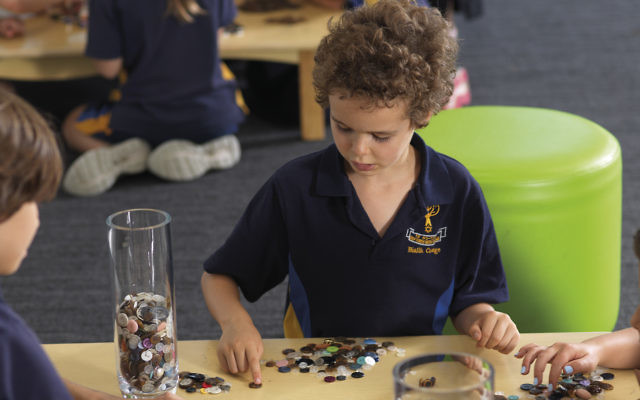Bialik’s button mission
Bialik College is on a mission to collect 600,000 buttons, searching all corners of the community and the country, for lost, forgotten or abandoned buttons.
BIALIK College is on a mission to collect 600,000 buttons, searching all corners of the community, and the country, for those that have fallen off, been forgotten or are simply lying around.
This is no ordinary sewing project, as the students have a very noble aim – to unite the community in collecting 1.5 million buttons to represent the life of each child murdered in the Holocaust.
Coming into its 10th year of button collection, the students, who first concocted the idea in 2007, have so far amassed approximately 900,000 buttons. They are vying to complete the collection by the end of this year.
It will culminate in an artistic sculpture being erected at the school, which will be comprised of 22 perspex cylinders of varying sizes to represent the different European countries the children came from.
Year 9 student Naomi Bagle-Zevin, who has been involved in the project since she was in year 4, said this year has seen a renewed emphasis on reaching the goal.
Encouraging donations, Bagle-Zevin said the students have placed button collection boxes at premises around the community, including The AJN, the Jewish Holocaust Museum, Beth Weizmann, and the Posh Opp Shoppe.
“I’ve taken quite a few boxes, I’ve put them in my physio, I have a few in Glick’s, just in all different places that I know there are lots of Jewish people.”
She said it is about more than just collecting the buttons; they have an aim to “spread awareness” and get people talking about their cause and the perished children of the Holocaust.
Back in 2007, the impetus for this initiative was sparked among a year 4 class watching Paper Clips, the documentary film about students in Tennessee collecting paper clips to represent the six million Jews killed by the Nazi regime.
Hoping to create a similar impact for the general community in Australia, Bagle-Zevin said she envisions the sculpture attracting students and visitors from the general community.
“I am hoping that eventually it’s not something the Jewish community does but something the whole [of] Melbourne can get involved in and understand the meaning behind it,” she said.
Coordinating the project is Hebrew and Jewish studies teacher Dalia Gurfinkel, who has been involved since the outset, when she helped launch it with former Bialik teacher Sony Levinson.
“It really develops a sense of Jewish identity,” Gurfinkel told The AJN when asked what sort of impact the project has had on students.
“We learn through action … For a child in year 2 to sit and count 100 buttons, they will remember why they did that.”
She noted that they have had buttons donated from as far as Darwin and New Zealand, with a number of non-Jewish people wanting to be involved. Gurfinkel feels the aim of the project, never to forget, is all the more pertinent in light of the number of living Holocaust survivors dwindling.
“It is really heartwarming to know that we are creating a very strong link; that the next generation is a strong link and not a weak one, with strong identity and very strong drive,” she said.
As part of this initiative, the contingent in charge of the collection has been trailed by a documentary team from SBS detailing their mission of receiving the last few hundred thousand buttons.
For more information visit their Facebook page.
ZOE KRON AND PHOEBE ROTH


comments